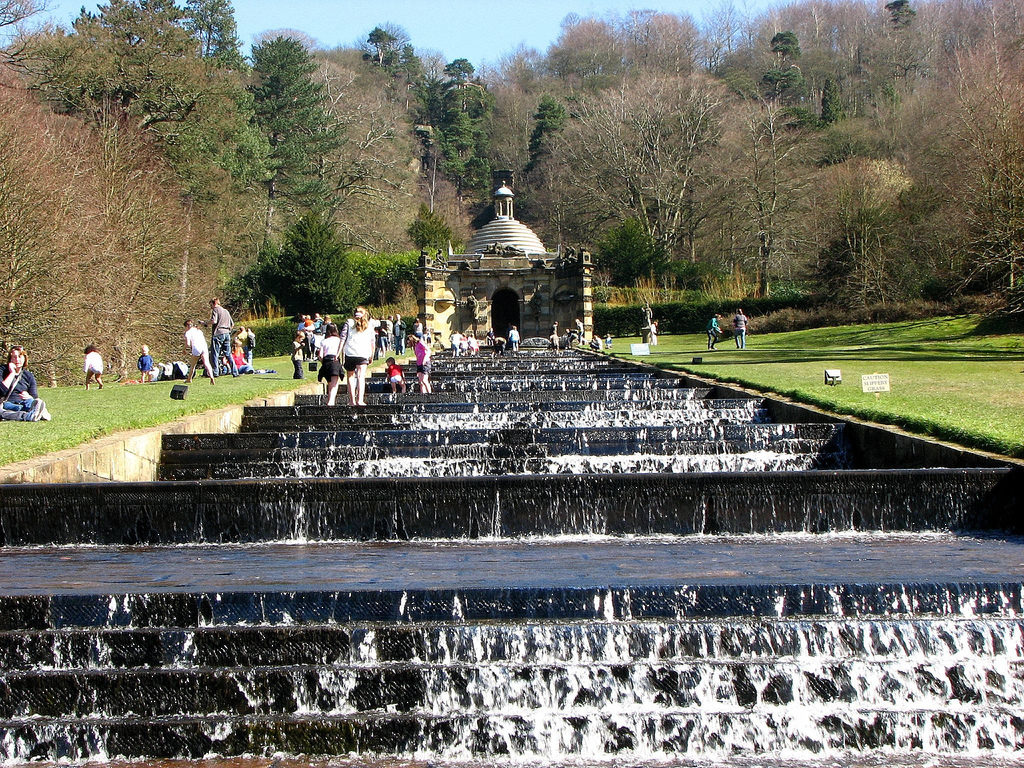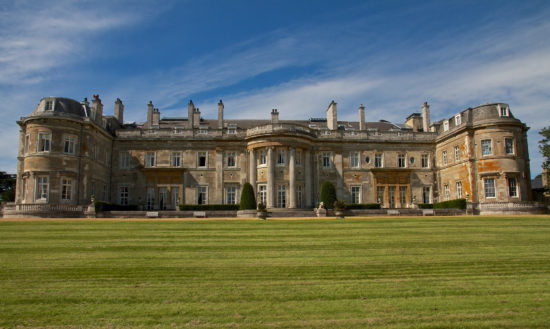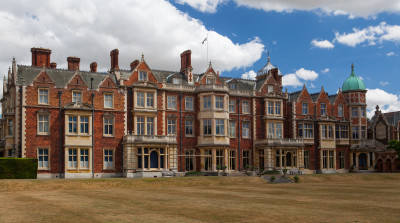In Britain we are fortunate enough to have a plethora of stately homes and country houses, built by the rich and powerful of centuries gone by, as a retreat from London, and as a symbol of wealth. None are finer, however, than Chatwsorth House, widely regarded as the jewel in the crown of our nation’s stately homes.

Chatsworth House is one Britain’s finest stately homes (Gareth Williams)
Set in the Derbyshire Dales less than 4 miles from Bakewell and 9 miles from Chesterfield, the house stands on the east bank of the River Derwent and is the seat of the Dukes of Devonshire.
LORD OF THE MANOR… SHUGBOROUGH HALL
There are few houses in Britain to rival the beauty of Chatsworth and few families to rival the importance of the Cavendishes. Dominating its own valley, one can sense the micro-climate that pervades the limestone edifice as it illuminates the stunning parkland, created to display the house in its true magnificence. Nature and architecture combine perfectly to show the visitor that the builders of this house truly intended to become immortal with an architectural legacy.
The Elizabethan Chatsworth
The Cavendish family first built a house on the Chatsworth estate in 1552, but there had been property on the site since the 10th century. The name ‘Chatsworth’ is thought to come from a corruption of ‘Chetel’s-worth’, meaning the Court of Chetel; Chetel was a Norseman who held lands in the area, but was deposed in the Norman conquest. The house is listed in the Domesday Book as ‘Chetesuorde’.

The Elizabethan hunting tower at Chatsworth (UAE Landscape)
The estate had been acquired in 1549 by Sir William Cavendish, Treasurer of the King’s Chamber to Henry VIII, and his young wife Elizabeth, also known as Bess of Hardwick; she was the second-most powerful woman in England in the late 16th century – only after Elizabeth I.
The house was built around a central courtyard with a gate tower, great hall and Chapel. Only two elements of this first house still survive today: The Hunting Tower, built in the 1580s, stands behind the house and is today let out as a holiday rental, and Queen Mary’s Bower, which stands by the bridge, used as a fishing platform.
The 17th century
It was not until the late 17th century that alterations started to be made to Chatsworth House. The 4th Earl of Devonshire rebuilt the South Front in the hope that it would attract a visit from the William III and Mary II, the new King and Queen. In 1694, he was promoted, being created 1st Duke of Devonshire for his part in bringing them to the throne, ousting James II, and thus securing a Protestant Monarchy for England.
BESIDE THE SEASIDE: OSBORNE HOUSE
He originally only intended to rebuild the South Front but enjoyed the work so much that he went on to rebuild the east, west and north fronts, too. This included the Painted Hall, the Long Gallery (now a library).

The magnificent Painted Hall at Chatsworth House depicts scenes of Cesar to impress William III – who never visited (Chris Ibbotson)

The Long Gallery, created at the end of the 1600s, is now a library (Shelly Rodrigo)
He brought in Frenchman, Grillet, to build the famous water cascade and Thomas Archer designed the temple at the top.
The new Chatsworth House was completed just before the Duke died in 1707.
The next phase of building that can still be seen today was begun under the 6th Duke, known as the ‘Bachelor Duke’ as he never married. He succeeded to the title in 1811, aged 21. He had a passion for collecting sculpture and built the North Wing to include a gallery for his collection, while numerous bedrooms were created in the east of the house for entertaining, leaving much of what we see as Chatsworth today.

A view up the cascade at Chatsworth House (Vanessa C)

An immensely popular feature in the grounds at Chatsworth, this cascade is gravity-fed from the Peak District moors. (Brian Smithson)
Two of the most famous gardeners of their time, Lancelot ‘Capability’ Brown and Joseph Paxton were employed at Chatsworth and their work can still be viewed today in the 100 acres of gardens and 1000 acres of parkland.
The Duke also had a keen interest in gardening and appointed Paxton as head gardener in 1826. In 1844, Paxton designed and constructed the famous Emperor Fountain; the jet in the canal pond could reach over 280 feet.
Paxton was also responsible for the cultivation of the Cavendish banana, from which 80% of the bananas consumed in the western world today are descended. He was additionally the designer of the Crystal Palace, venue for the Great Exhibition of 1851. In fact, it was the structure of a giant lily pad sent to Chatsworth that inspired Paxton in his design for the huge glass and cast-iron structure.

The Emperor Fountain seen from the end of a longwater at Chatsworth House (canong2fan)
Capability Brown sculpted rolling green slopes, a perimeter belt of trees to enclose the view, and carriage drives with carefully planned views.
REAL TENNIS CHAMPIONSHIP AT HAMPTON CORT – GET TICKETS!
The Cavendishes are responsible for building some of the great landmarks of 18th century London, most notably Burlington Arcade and Burlington House, location of the annual Summer Exhibition of the Royal Academy.
The 8th Duke (1833-1908) and his wife Louise Von Alten entertained on a very grand scale and some of the costumes from their ‘party of the century’ can be seen as the centre piece of the current exhibition, ‘House Style’.
20th century Chatsworth
During World War II, like many country houses, Chatsworth was repurposed, and used as a girls’ boarding school.
In May 1944, the 10th Duke’s eldest son, William, Marquess of Hartington, married Kathleen Kennedy, sister of John F Kennedy. Four months later he was tragically killed in action while serving with his regiment, and Kathleen died in a plane crash in 1948. But for these dreadful events, there would have been a Kennedy as Duchess of Devonshire at Chatsworth.
The Duke’s second son, Andrew Cavendish succeeded to the title on his father’s death in 1950. Faced with 80% death duties many of the most important works of art and rare books were sold off, as well as nearby Hardwick Hall, from where Bess got her name.
It wasn’t until 1959 that the family decided to move into Chatsworth. The Duke had considered selling it off, and, but for his and the Duchess’ foresight, Chatsworth today could well have been some corporate headquarters for a global enterprise.
They decided to open the house to the public. Although visitors had been able to look around the house since the 1600’s, this was the beginning of turning Chatsworth into the visitor attraction we know today.
The wife of the 11th Duke was Deborah ‘Debo’ Mitford, of Mitford sisters fame. She became much of the driving force behind making the house not only a world renowned attraction, but also financially viable. Nowadays most stately homes have a farm shop selling produce from the estate, Chatsworth was the first to embark on such an enterprise in 1977.
The current occupants of Chatsworth are the 12th Duke of Devonshire, Peregrine Cavendish and Duchess Amanda; they are collectors of contemporary art, and have added to the house collection, which has largely remained dormant since the mid 1850’s. Don’t be too surprised therefore to see works by the likes of Damien Hirst set in the grandeur of the 18th century state rooms.
‘House Style: Five Centuries of Fashion at Chatsworth’
The Duke and Duchess are now coming to the end of a 10 year, £37 million renovation of the exterior of the house, which will be completed in November. This extensive works has seen quarries reopened to obtain stone to match the original, the replacing of the magnificent gilding of the ornamentation, and re-leading the roof will ensure structural stability to the house for a further 200 years.
However, the future of this Derbyshire gem wasn’t always so reassured: regular exhibitions are an innovative way of keeping visitors returning. The house first opened its doors at Christmas in 2001 after the outbreak of foot and mouth had affected the local economy so badly, and has opened every Christmas since, showing the house festively decorated in a new and unique way each year.
The current exhibition, “House Style: Five Centuries of Fashion at Chatsworth” has been curated by Laura Burlington (the current heir’s wife), Hamish Bowles (American Vogue’s International editor-at-large), costume historian Patrick Kinmouth, and his creative partner Antonio Monfredo.
Highlights of the exhibition include Deborah, the late Dowager Duchess’s coronation robes worn at the coronation of Queen Elizabeth II in 1953. She had to get special dispensation from the Queen to wear the robes that were originally made for Queen Victoria’s coronation, as they were styled to be worn off the shoulder, and not considered to be the appropriate coronation mode for a Duchess of 1953.
The robes are displayed at the top of the staircase that rises from the Painted Hall, arguably the most spectacular room in the house.

Debo’s coronation robes sit at the top of the grand staircase in the Painted Hall (Stephen Taylor)
#duchessofdevonshire #coronationrobes #housestyleexhibition #chatsworthhouse
A post shared by Sam Bird (@mamfb) on
The painted decoration from which the room gets its name is the only part of the interior that survives from the original building of 1687-1694. The paintings by Louis Laguerre (1663-1771) show scenes from the life of Julius Caesar and were designed to flatter the new King, William III.
The centre piece of the exhibition are the costumes from the ‘party of the century’, held at the Cavendish’s London home, Devonshire House, in 1897 by the 8th Duke and his wife Louise, to celebrate Queen Victoria’s Diamond Jubilee. The party was fancy dress, or ‘costume ball’ and was recorded by celebrated photography firm Lafayette.
A post shared by Dennita Sewell (@dennita_sewell) on
Six of the dresses from the ball are reunited for the exhibition, including Duchess Louise’s dress, who attended as Queen Zenobia of Palmyra. A dazzling creation of gold, shot silk gauze, velvet, tissue, crepe de chine and satin. It was made by Jean Philippe Worth from a design by Attilio Comelli, costume designer to the Royal Opera House.
In the chapel are wedding gowns, christening gowns and mourning wear, depicting the circle of life.
House of Style. Definitely worth the trip.
A post shared by Miss Bella Bird (@missbellabird) on
The climax to the exhibition is the Great Dining Room scene, a cavalcade of 30 costumes by designers including Chanel, Vivienne Westwood, Tom Ford and Dior, arranged as guests attending a 21st century ‘party of the century’.
The exhibition runs until 22 October – get tickets here.
A post shared by Roger Leong (@rogerleonginstagram) on






